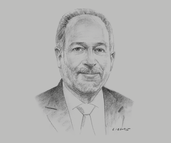Federico Patiño Márquez : Interview

Interview : Federico Patiño Márquez
Once operational, how will the new airport compare to other major global aviation centres?
FEDERICO PATIÑO: Mexico’s excellent geographic location, connecting North and South America, with Europe and Asia to each side, can truly allow the country to become a hub not just for the region, but also for the world. To achieve this, it is important that we provide an airport of the largest possible proportions with a capacity to handle 125m passengers a year. Only Istanbul has a larger airport in construction. The main terminal will be 1.5 km in length, cover 743,000 sq metres and have 96 contact gates for aircraft of all sizes.
The project has so far created 45,000 direct and indirect jobs, which will increase to 160,000 during the construction phase. We are building three runways initially, with the potential for this to be doubled to six at a later stage. This is the only airport outside the US that will be able to have all three runways handling takeoffs and landings simultaneously.
What associated facilities are being developed to bolster activities other than civil aviation?
PATIÑO: Aside from passengers, it is important to provide comprehensive infrastructure for other users of the airport, such as cargo operators, which we hope to concession out to private bidders. From freight operators to Customs authorities, we plan to have a dialogue with all stakeholders to ensure the design of these areas complies with their requirements. This is in the country’s economic interest as it continues to manoeuvre itself to become a regional hub for cargo, as well as for passenger traffic. The plans include a 200,000-sq-metre storage space for cargo, quadruple the size of the area in the existing airport. In addition, the development of nearby industrial parks is fundamental to support the logistics ecosystem.
Ecatepec, the area in the eastern part of Greater Mexico City where this airport is being constructed, has suffered from a lack of service growth over recent decades, and it is hoped that the airport’s logistics activities will, through the multiplier effect, boost local economic development.
How are financing mechanisms being implemented to ensure the cost and risk of the project is shared among different public and private sector actors?
PATIÑO: When this project was conceived in mid-2014, it was understood that government resources would be limited. For that reason, we designed a scheme to diversify our income sources and avoid generating public debt by securitising passenger levies paid on the existing airport levies.
It matured in 2015 with strong results that allowed us to diversify our investment portfolio, whereby 30% now comes from public resources and 70% from resources raised from capital markets.
To supplement this bond emission, we did a roadshow through Asia, Africa and Europe to generate interest from the international community. Airports have always attracted interest from investors, simply because they are an infrastructure necessity for any country or city; the roadshow generated $6bn for the project, with much of the money coming from non-traditional investors. Our efforts were aided by the highest ratings qualification from both Moody’s and Standard & Poor’s, which provide third-party backing for the financial viability of the project.
The fact that this will be the world’s most sustainable airport – and the first passenger terminal to be certified LEED v4 – also helps bolster its image. It is well known that many investors in developed markets do not consider investing in a project if it does not have green credentials. In addition, a new type of investment trust, the fideicomiso de inversión y bienes raíces E, or FIBRA E, launched in March 2018, raised $1.6bn, further underscoring investors’ faith in the project. Some 45% of investment came from pension funds, 54% from investment funds and 1% from international investors.
You have reached the limit of premium articles you can view for free.
Choose from the options below to purchase print or digital editions of our Reports. You can also purchase a website subscription giving you unlimited access to all of our Reports online for 12 months.
If you have already purchased this Report or have a website subscription, please login to continue.

